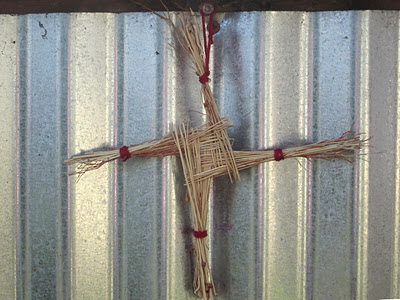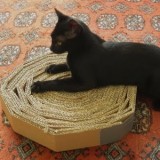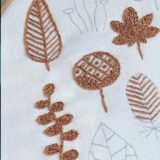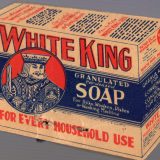Many thanks to reader Maribeth for turning us on to this subject, and sharing a great video. I liked it so much I had to share it with you all in turn. She sent us this nice short article on Colossal, which has an overview, more photos and some good links to explore, as well as the video I’m embedding here.
Kintsugi is the Japanese art of mending broken ceramics with gold or silver lacquer patching which emphasizes rather than hides the break patterns. The resulting piece is often more beautiful than the original, an embodiment of wabi-sabi, and an invitation for meditation on beauty, loss, transformation, wounding, scars, entropy… The responses, I suspect, would be as individual as the viewer.
This art-of-mending seems related, somehow, to the “oh no, it’s the end times!” stuff Erik and I were blogging about last week (here and here). Kintsugi is such a subtle, wise practice. It’s not about fixing something good as new, as if it had never broken, but acknowledging that breakage, and making something new and beautiful out of disaster, via the practice of mindfulness. Perhaps we can learn something from this.
Please do check out the video–it’s short and beautiful. In it, a young craftsman explains the rising popularity of this 400 year-old art form in Japan, says, ” …people are realizing that chasing after money and new stuff and new technology will not make us rich in (s) spiritual way.”

image: Wikipedia





Absolutely lovely! There is a Dutch man who lives in the UK and specializes in what he calls “visible mending”, which applies these same kintsugi principles to knitted or woven cloth clothing items – regardless of whether the item was originally handmade or storebought. He describes what his does as follows:
“The Visible Mending Programme seeks to highlight that the art and craftsmanship of clothes repair is particularly relevant in a world where more and more people voice their dissatisfaction with fashion’s throwaway culture. By exploring the story behind garment and repair, the Programme reinforces the relationship between the wearer and garment, leading to people wearing their existing clothes for longer, with the beautiful darn worn as a badge of honour. By writing this blog, running darning workshops and taking repair work commissions I provide mending inspiration, skills and services to people and hopefully persuade them that shop-bought clothes deserve care and attention too, just like a precious hand-knit.”
Here is a post of his describing a commission piece he recently finished: http://tomofholland.com/2014/05/02/a-mothers-work/
Thank you for posting this. I love the idea that cherished items are repaired and taken care of and can be made more beautiful and artistic. I think this could also be used as an analogy for how we treat the elderly, handicapped, and less fortunate in our society.
Too many times I’ve just throw something broken away and then longed for it’s presence. Everything has an energy. “Respect” may be another idea needing to be explored more. Respect for the service the item has provided.
This post has given me food for thought. Thanks!
I was also going to link to Tom of Holland’s visible mending, and to visible repairs by Paulo Goldstein, he calls it “Repair is Beautiful”: http://paulogoldstein.com/Repair-is-Beautiful
I love this concept, it doesn’t remind of the end times, but rather as you say of mindfulness, of a way of living that honors the things we use and love, rather than treating everything as disposable.
@P and @Tasha
Thank you both for Tom of Holland–what a fantastic site. And he turned me onto Felicity Ford, and Helen Whitham. omg.
And Paolo Goldstein’s stuff is wonderful too, in a different way–more playful.
And now I’ve spent an hour on the internet when I was supposed to be doing something else…
🙂
Along the lines of Tom, Felicity & Helen & the whole “Slow Clothing” movement, this book by India Flint is a wonderful resource for both contemplation as well as practical information about choosing and caring for items of clothing:
“Second Skin: Choosing and Caring for Textiles and Clothing”
http://www.amazon.com/Second-Skin-Choosing-Textiles-Clothing/dp/174196721X/ref=la_B0034OIRHM_1_2?s=books&ie=UTF8&qid=1400182594&sr=1-2
see also the work of the folks at http://www.fibershed.com for an ongoing “slow clothing” project based out of Northern California. The “Gold Coast Fibershed” is trying to recreate this model for those of us in SoCal.
What’s so delicious is that all of this goes beyond just depression-era mentality of “use it up, wear it out, make it do or do without…” etc, but to really having deeper mindfulness and connection to the beauty of appreciating not only what is right in front of you if you are willing to see, but in exercising one’s sense of enhancing the beauty around you to appreciate those things even more, while still keeping the aspects of practicality/frugality. It also plays deeply with some of the notions of what is truly “eco-conscious”/sustainable. Lovely stuff, indeed.
Far from “end times,” the image on this post was so touching to me.
Right now brushfires rage around San Diego, and years ago my family lost our home in wildfires. I salvaged some pieces of my late mother’s ceramic bowls, which were about all we had left after the fires. How beautiful it would be to mend them in such a way.
Anyone who has sewn much at all has eventually cut an unintentional hole or slash in fabric while cutting out garment pieces out for sewing. At one time or another someone has contemplated throwing it away or cutting something else from the ruined garment.
For several reasons, I never threw anything away. 1) This was a favorite piece of fabric, 2) Maybe I needed something to wear and had nothing else or nothing else suitable for the garment I was making/needing. 3) Maybe I had no money to buy anything else.
My mother taught me the art of mending and making the mend part of the design. I could use contrasting fabric and applique something on the hole. I could embroider over the hole. Maybe a mock placket could hide a cutting mistake.
Through the years I used this skill/mindset to salvage ruined garments for others. I commanded a good price for this effort and skill. When someone bemoaned that a beloved garment was torn, they knew I could fix it. A cascade of leaves appliqued down the front of a stained, favorite blouse actually enhanced the garment. I put two or three leaves on the pants that matched. The woman told me she had gotten so many compliments…yeah, for a artistic mend/save.
Pots mended 150 years ago with a dam by a tinker command a high price today in antique malls. The pot was valuable, but substandard by our standards. The skillful mend was not meant to be artistic, just utilitarian, yet people value the skill employed by the tinker. Hung in a country kitchen with the dam showing the mend, it is now art.
If mending is a sign of end times then I guess I’ve been preparing for it all my life.
I sew and knit and I repair and repurpose,from mending to appliques to unravelling and re knitting.
I never really thought of it as and art form just getting the most use out of what I buy.
We use the 6 million dollar man expression in our house “we can make this better than new,we have the technology, we have the Know How”
Thanks for this post and the links posted, loads of great ideas and inspirations.
Who is the narrator of the video, I can’t catch his name?